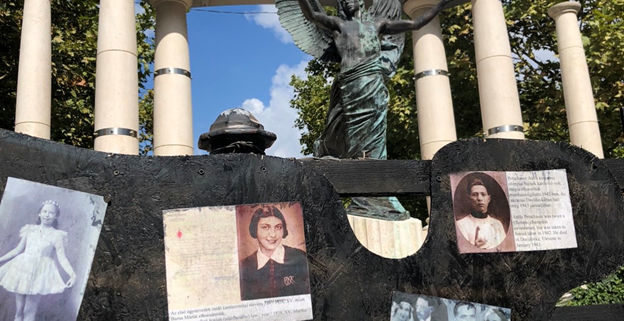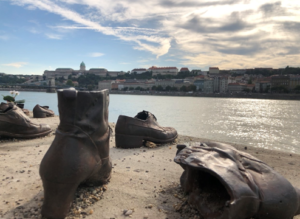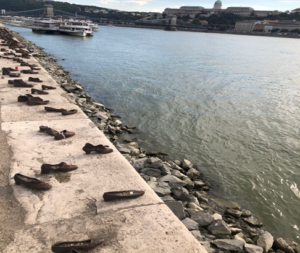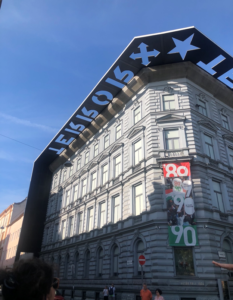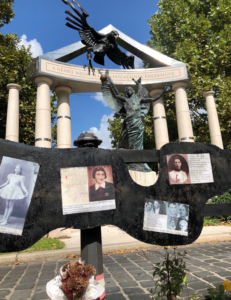A Proper Monument to the Jewish Victims of the Holocaust
By Hannah Gavin
“How does one mourn for six million people who died? How many candles does one recite? Do we know how to remember the victims, their solitude their helplessness? They left us without a trace, and we are their trace.”
- Ellie Wiesel
Elie Wiesel asks us in that quote, as the next generation, to think critically about how we remember the Holocaust. Visual representations of history are crucial to continue stories. These depictions, sometimes of in the form of sculptures, architecture or theatre, allow us to reflect on a piece of history. They often attempt to evoke emotions and typically, they strive to educate their audience about the history that they touch upon. However sometimes, these representations of the past leave the viewers more confused than they do informed. When we view these monuments, for example, we have to ask, what should they teach us? Throughout my time traveling I have learned, monuments are only valuable resources if they are surrounded by meaningful information explaining their purpose and the histories, they are there to memorialize.
In Budapest, it is easy to ignore the monuments around the city. To the untrained eye, one may believe that they are simply works of art. One example is the Shoes on the Danube. These pairs of shoes are meant to commemorate the thousands of Jewish victims who were marched from the Budapest Ghetto by the Nazi collaborating Arrow Cross party of Hungary and shot on the edge of the Danube river. Too often today, these victims are remembered as a statistic. Roughly 20,000 people were shot on that banks of the Danube in central Budapest; we too often forget that those were individuals, with lives and stories to tell. However, this memorial forces the victims to remain an anonymous statistic. To some knowledgeable viewers, this is a symbolic marking of a massacre, because they know the history behind the memorial. However, many people who walk past this site are unaware of this past. The only words of explanation on the site are in the form of a plaque that reads, “To the Memory of the Victims Shot into the Danube by the Arrow Cross Militia Men in 1944-45”. The words are blatant in their omission of specific information pointing to the fact that the victims of these crimes were Hungarian Jews. When I visited the monument, I stood looking over the water and the shoes surrounded by my classmates and my professors, all members of a group that has dedicated significant time to studying these issues. And then I attempted to be someone else. What would I think of this monument if I hadn’t already known what it stood to symbolize? With no words to the true victims, I would likely pass right by.
Budapest’s House of Terror is another notable institution engaged in representation of Hungarian history. The museum’s focus is on the display of the horrors that befell the people of Hungary as a result of the so-called double occupation of Hungary – first by Nazi Germany, and then the Soviet Union. This “museum” has been criticized for its portrayal of the Communist era history of Hungary. However, the museum faces other criticism as well. One critic confronted the lack of information throughout the museum regarding the Holocaust. In “Terror on Andrassy Boulevard,” Andras Szántó writes: “The less obvious slippages and silences of the museum will elide the foreign visitor…” (Szántó, 42). The museum also fails to acknowledge that Hungary’s Arrow Cross party collaborated with Nazi Germany to murder roughly 800,000 Hungarian Jews. When I toured the museum, it was with guidance of a trained guide. Albeit ignoring the question of who the tour guides are trained by, without her information, I would have been lost. In one room we were led to an installation depicting a scene of an icy bit of water projected on a screen. The sound of splashing surrounds us. This was their representation of the history of Budapest Jews that were murdered at the Danube. Without context, this is a confusing and meaningless display. This installation felt more like a showoff of interesting architecture and a theater show than it did an informative exploration of the history of atrocities during WWII in which non-Jewish Hungarians were complicit.
Installations that focus on history can be entertaining, although that should not be their primary purpose. It is the responsibility of those creating these places to provide necessary information. As we learned, this is not always as simple as it sounds. There is an impossible to ignore difference in the way that the Hungarian government handled Holocaust memory during the Soviet occupation, and after. However, we must be critical of the information even today that we receive and where it is coming from. The lack of historical information at these sites is deeply disturbing. The thing the commemorative projects I have considered have in common, is that through a lack of words, they paint the Hungarian nation as victims of Nazi terror. They do not include the relevant history of Hungarians being complicit in the atrocities and the importance that the Jewish Hungarian people, were the true victims of this brutality. (Petõ, 2).
One memorial that seemed to break this trend of lack of information or misinformation was the Living Memorial located on Liberty Square in Budapest. Situated in front of the Memorial to the Victims of the German Occupation, this installation was the most informative of all that I saw. The Living Memorial is a small compilation of photos, text and physical items. It seeks to explain the murder of the Hungarian Jews during the Holocaust. Behind the living memorial sits a monument to the “occupation of the Germans”. An angelic figure symbolizing Hungary with a frightening looking eagle hovering above, appearing to attack. The eagle symbolizes Nazi Germany, this monument lacks context. It appears to be showing an “angelic” Hungary being attacked by a fearsome Germany. This monument is dangerous as it attempts to insert Hungary as a helpless victim of the Nazi regime. Just in front of this statue sits the Living Memorial, it is a strung together cluster of laminated biographies and detailed account of the Jewish people murdered from within Hungary during the Second World War. It attempts to fill in the proper history of the Jewish people that the Hungarian government ignores. The burden has been placed on survivors, families and other individuals to create and maintain this memorial. This installation is in multiple languages, it contains physical artifacts along with photos and typed biographies of Jewish individuals. It seeks to not only be intriguing, it sought to inform the viewer about the history it presented. Due significantly to this information, it remains one of the most compelling memorials to the Holocaust that I have witnessed.
Installations of history are complex. There is no one right way to present something. Different people with different backgrounds can interpret things in various ways which can contribute to a deeper understanding, or confusion. It is impossible as an artist or curator, to have everyone interpret your vision as you may have. It is therefore pertinent that we inform viewers of such installations, about the truth of the history behind them. There is a fine line creative of commemorative works must walk when presenting history. That is the line between informing and entertaining. A certain amount of entertainment may be necessary to capture one’s imagination about the past. However, too much and an installation becomes a diversion from the real-life event that is being remembered. An ignorance to the marginalized groups that faced persecution during these times, leaves room for revisionist history and opens the door for vague descriptions of history that seek to exclude the real victims. (Vrzgulová, 1). The most meaningful monuments are those that not only evoke our emotions but teach us the true history of the ground that they stand on. If we are the victims’ trace as Wiesel said, it is our responsibility to create monuments grounded in fact and deliberate in their efforts to memorialize the millions of Jewish victims of the Holocaust.
Works Cited:
Petõ, Andrea. 2014. “Hungary 70”: Non-remembering the Holocaust in Hungary.” Culture & Hisotry
Digital Journal, 3(2): 2.
Szanto, Andras. 2003. “Terror on Andrassy Boulevard.” Print 57 (1): 42.
Vrzgulová, Monika. 2016. “Memories of the Holocaust: Slovak Bystanders.” 1.

